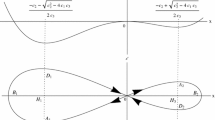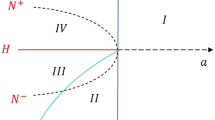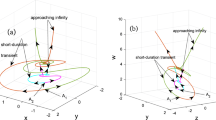Abstract
This paper proposes an \(L^p\) optimal control method to shift the homoclinic bifurcation of single-degree-of-freedom nonlinear oscillators. The homoclinic intersection between stable and unstable manifolds is detected analytically using the Melnikov method. An optimization strategy is formulated to obtain the control gain that minimizes the absolute value of the largest magnitude characteristic multiplier of the periodic orbit that emerges due to the shift of the homoclinic bifurcation. The optimal control gain is obtained by considering the stability of this periodic orbit. The cross-entropy method is used to obtain a numerical optimal solution to the optimization problem and, consequently, to obtain an optimal controller for the feedback method presented here. As an example of the \(L^p\) optimal control strategy, we consider the periodically forced Duffing oscillator with a twin-well potential. The numerical results demonstrate the capability of the \(L^p\) optimal control procedure to shift the homoclinic bifurcation. Moreover, the \(L^p\) optimal control can help regularize the fractal basin boundaries of the two confined attractors in the two potential wells.










Similar content being viewed by others
Data availability statement
The manuscript has no associated data.
References
Chicone, C.: Ordinary Differential Equations with Applications. Springer (2006)
Nayfeh, A.H., Balachandran, B.: Applied nonlinear dynamics: analytical, computational, and experimental methods. John Wiley & Sons (2008)
Lenci, S., Rega, G.: Optimal numerical control of single-well to cross-well chaos transition in mechanical systems. Chaos, Solitons Fractals 15(1), 173–186 (2003). https://doi.org/10.1016/S0960-0779(02)00116-9
Rega, G., Lenci. S, Thompson, J.M.: Controlling chaos: the OGY method, its use in mechanics, and an alternative unified framework for control of non-regular dynamics. In Nonlinear Dynamics and Chaos: Advances and Perspectives. Springer 211-269 (2010). https://doi.org/10.1007/978-3-642-04629-2_11
Lenci, S., Rega, G.: Optimal control of homoclinic bifurcation: theoretical treatment and practical reduction of safe basin erosion in the Helmholtz oscillator. J. Vib. Control 9(3–4), 281–315 (2003). https://doi.org/10.1177/107754603030753
Lima, R., Pettini, M.: Suppression of chaos by resonant parametric perturbations. Phys. Rev. A 41(2), 726 (1990). https://doi.org/10.1103/PhysRevA.41.726
Dzhanoev, A.R., Loskutov, A., Cao, H., Sanjuán, M.A.: A new mechanism of the chaos suppression. Discrete Contin. Dyn. Syst. B 7(2), 275 (2007). https://doi.org/10.3934/dcdsb.2007.7.275
Lenci, S., Rega, G.: Optimal control of nonregular dynamics in a Duffing oscillator. Nonlinear Dyn. 33(1), 71–86 (2003). https://doi.org/10.1023/A:1025509014101
Lenci, S., Rega, G.: Control of the homoclinic bifurcation in buckled beams: infinite dimensional vs reduced order modeling. Int. J. Non-Linear Mech. 43(6), 474–89 (2008). https://doi.org/10.1016/j.ijnonlinmec.2007.10.007
Lenci, S., Rega, G.: Global optimal control and system-dependent solutions in the hardening Helmholtz-Duffing oscillator. Chaos, Solitons Fractals 21(5), 1031–46 (2004). https://doi.org/10.1016/S0960-0779(03)00387-4
Cao, H.: Primary resonant optimal control for homoclinic bifurcations in single-degree-of-freedom nonlinear oscillators. Chaos, Solitons Fractals 24(5), 1387–98 (2005). https://doi.org/10.1016/j.chaos.2004.09.084
Chacón, R., Martínez, P.J., Martínez, J.A.: Dissipative dynamics of a particle in a vibrating periodic potential: chaos and control. Phys. Rev. E 92(6), 062921 (2015). https://doi.org/10.1103/PhysRevE.92.062921
Chacón, R.: Role of ultrasubharmonic resonances in taming chaos by weak harmonic perturbations. EPL (Europhys. Lett.) 54(2), 148 (2001). https://doi.org/10.1209/epl/i2001-00288-6
Chacón, R., Martínez, J.A.: Inhibition of chaotic escape from a potential well by incommensurate escape-suppressing excitations. Phys. Rev. E 65(3), 036213 (2002). https://doi.org/10.1103/PhysRevE.65.036213
Chacón, R., Miralles, J.J., Martínez, J.A., Balibrea, F.: Taming chaos in damped driven systems by incommensurate excitations. Commun. Nonlinear Sci. Numer. Simul. 73, 307–318 (2019). https://doi.org/10.1016/j.cnsns.2019.02.014
Martínez, P.J., Euzzor, S., Meucci, R., Chacón, R.: Suppression of chaos by incommensurate excitations: Theory and experimental confirmations. Commun. Nonlinear Sci. Numer. Simul. 83, 105–137 (2020). https://doi.org/10.1016/j.cnsns.2019.105137
Piccirillo, V.: Control of homoclinic bifurcation in two-dimensional dynamical systems by a feedback law based on \(L^p\) spaces. J. Franklin Inst. 359, 5097–5124 (2022). https://doi.org/10.1016/j.jfranklin.2022.04.032
Rubinstein, R.Y.: Optimization of computer simulation models with rare events. Eur. J. Oper. Res. 99(1), 89–112 (1997). https://doi.org/10.1016/S0377-2217(96)00385-2
Rega, G., Settimi, V.: Global dynamics perspective on macro-to nano-mechanics. Nonlinear Dyn. 103, 1259–1303 (2021). https://doi.org/10.1007/s11071-020-06198-x
Hacker, E., Gottlieb, O.: Local and global bifurcations in magnetic resonance force microscopy. Nonlinear Dyn. 99(1), 201–225 (2020). https://doi.org/10.1007/s11071-019-05401-y
Awrejcewicz, J., Holicke, M.: Analytical prediction of chaos in rotated Froude pendulum. Nonlinear Dyn. 47, 3–24 (2007). https://doi.org/10.1007/s11071-006-9054-8
Zhao, F., Ma, X., Cao, S.: Periodic bursting oscillations in a hybrid Rayleigh-Van der Pol-Duffing oscillator. Nonlinear Dyn. 111, 2263–2279 (2023). https://doi.org/10.1007/s11071-022-07940-3
Han, N., Lu, P., Li, Z.: An approximate technique to test chaotic region in a rotating pendulum system with bistable characteristics. Nonlinear Dyn. 104, 191–214 (2021). https://doi.org/10.1007/s11071-021-06274-w
Guckenheimer, J., Holmes, P.: Nonlinear oscillations, dynamical systems, and bifurcations of vector fields. Springer (1983)
Perko, L.: Differential Equations and Dynamical Systems. Springer (2013)
Slotine, J.J., Li, W.: Applied Nonlinear Control. Prentice hall (1991)
Tereshko, V., Chacón, R., Preciado, V.: Controlling chaotic oscillators by altering their energy. Phys. Lett. A 320(5–6), 408–16 (2004). https://doi.org/10.1016/j.physleta.2003.11.057
Strogatz, S.H.: Nonlinear Dynamics and Chaos: with applications to physics, biology, chemistry, and engineering. CRC Press (2018)
Deshmukh, V.S., Sinha, S.C.: Control of dynamic systems with time-periodic coefficients via the Lyapunov-Floquet transformation and backstepping technique. J. Vib. Control 10(10), 1517–1533 (2004). https://doi.org/10.1177/1077546304042064
Pyragas, K.: Delayed feedback control of chaos. Philos. Transact. Royal Soc. A Math. Phys. Eng. Sci. 364(1846), 2309–2334 (2006). https://doi.org/10.1098/rsta.2006.1827
Zheng, Y.G., Yu, J.L.: Stabilization of multi-rotation unstable periodic orbits through dynamic extended delayed feedback control. Chaos, Solitons Fractals 161, 112362 (2022). https://doi.org/10.1016/j.chaos.2022.112362
Montagnier, P., Spiteri, R.J., Angeles, J.: The control of linear time-periodic systems using Floquet-Lyapunov theory. Int. J. Control 77(5), 472–90 (2004). https://doi.org/10.1080/00207170410001667477
Chagas, T.P., Toledo, B.A., Rempel, E.L., Chian, A.L., Valdivia, J.A.: Optimal feedback control of the forced van der Pol system. Chaos, Solitons Fractals 45(9–10), 1147–56 (2012). https://doi.org/10.1016/j.chaos.2012.06.004
Rubinstein, R.: The cross-entropy method for combinatorial and continuous optimization. Methodol. Comput. Appl. Probab. 1(2), 127–90 (1999). https://doi.org/10.1023/A:1010091220143
Cunha, A.: Enhancing the performance of a bistable energy harvesting device via the cross-entropy method. Nonlinear Dyn. 103(1), 137–55 (2021). https://doi.org/10.1007/s11071-020-06109-0
Rubinstein, R.Y., Kroese, D.P.: The cross-entropy method: a unified approach to combinatorial optimization, Monte-Carlo simulation, and machine learning. Springer (2004)
Kroese, D.P., Porotsky, S., Rubinstein, R.Y.: The cross-entropy method for continuous multi-extremal optimization. Methodol. Comput. Appl. Probab. 8(3), 383–407 (2006). https://doi.org/10.1007/s11009-006-9753-0
Nusse, H.E., Yorke, J.A.: Dynamics: Numerical Explorations. Springer (2012)
Funding
The authors declare that no funds, grants, or other support were received during the preparation of this manuscript.
Author information
Authors and Affiliations
Corresponding author
Ethics declarations
Conflict of interest
The authors declare that they have no conflict of interest.
Additional information
Publisher's Note
Springer Nature remains neutral with regard to jurisdictional claims in published maps and institutional affiliations.
Appendix A: CE optimization Algorithm
Appendix A: CE optimization Algorithm
This appendix presents the computational recipe for the CE procedure. The algorithm for the computational implementation of the CE method is shown in Algorithm 1.

Rights and permissions
Springer Nature or its licensor (e.g. a society or other partner) holds exclusive rights to this article under a publishing agreement with the author(s) or other rightsholder(s); author self-archiving of the accepted manuscript version of this article is solely governed by the terms of such publishing agreement and applicable law.
About this article
Cite this article
Piccirillo, V. \({L}^{\varvec{p}}\) optimal feedback control of homoclinic bifurcation in a forced Duffing oscillator. Nonlinear Dyn 111, 13017–13037 (2023). https://doi.org/10.1007/s11071-023-08575-8
Received:
Accepted:
Published:
Issue Date:
DOI: https://doi.org/10.1007/s11071-023-08575-8




